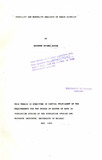| dc.description.abstract | This study investigates the relationship between fertility and
child mortality in Kwale district. Our first objective was to
estimate the total fertility rate (TFR), the mean closed birth
interval (MCBl) and child mortality q(2) using 1979 census data
by division, education, marital status and residence
differentials. Simple correlation analysis was then used to
establish the relationship existing between birth interval and
child mortality in the district. The results show that the length
I of average birth interval and child mortality (q2) are negatively
related though weakly.
Further analysis using a sample of children from three locations
in Kwale district included in the Child Survival and Development
Baseline Survey (1987), show that the length of the previous
birth interval and the subsequent birth interval have a
significant impact on infant/child mortality whether duration of
breastfeeding is taken into account or not. However, long
previous birth intervals are favourable to survival at childhood
while long subsequent intervals reduce the risk of mortality in
infancy. Also, the age at which supplementation starts is an
important determinant of child survival in Kwale District | |

